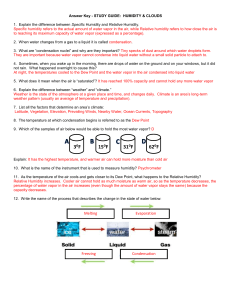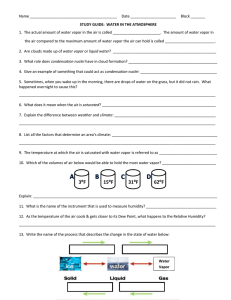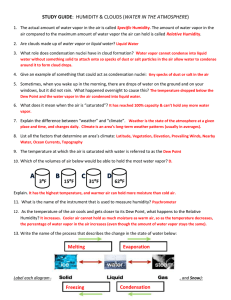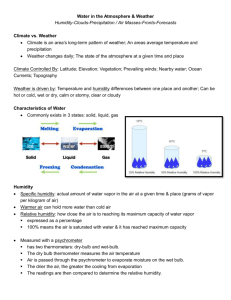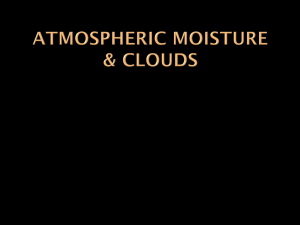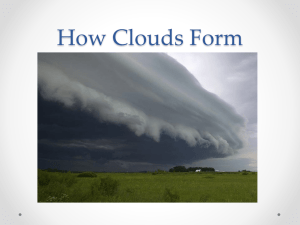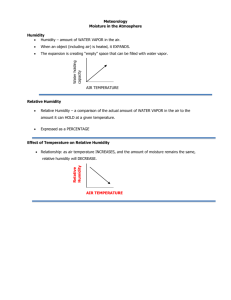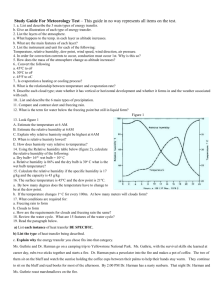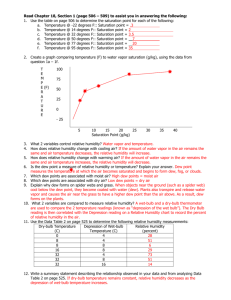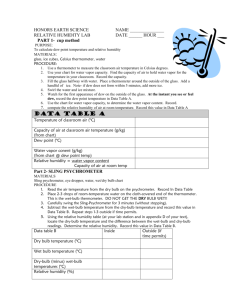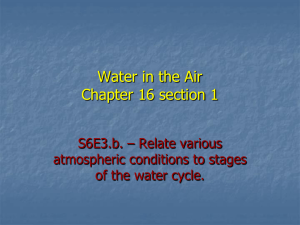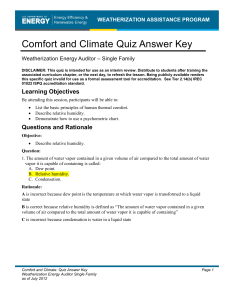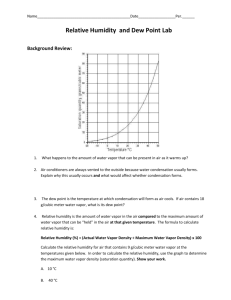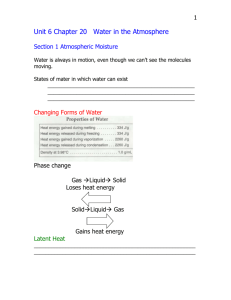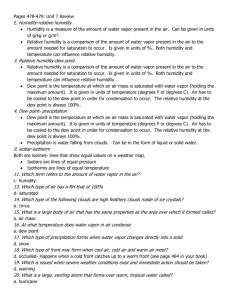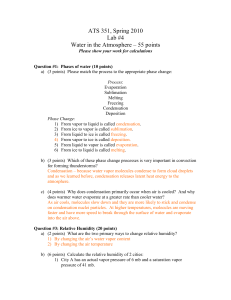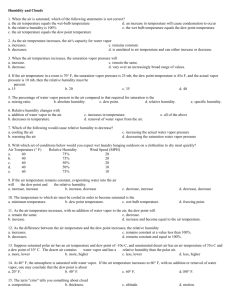Answer Key
advertisement
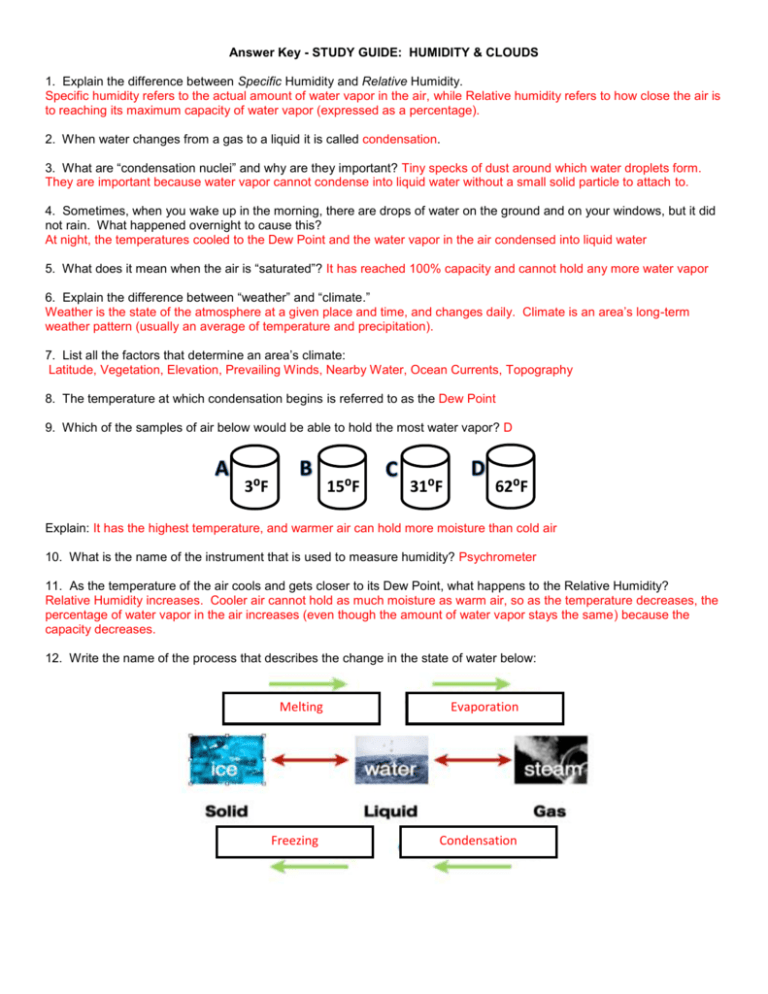
Answer Key - STUDY GUIDE: HUMIDITY & CLOUDS 1. Explain the difference between Specific Humidity and Relative Humidity. Specific humidity refers to the actual amount of water vapor in the air, while Relative humidity refers to how close the air is to reaching its maximum capacity of water vapor (expressed as a percentage). 2. When water changes from a gas to a liquid it is called condensation. 3. What are “condensation nuclei” and why are they important? Tiny specks of dust around which water droplets form. They are important because water vapor cannot condense into liquid water without a small solid particle to attach to. 4. Sometimes, when you wake up in the morning, there are drops of water on the ground and on your windows, but it did not rain. What happened overnight to cause this? At night, the temperatures cooled to the Dew Point and the water vapor in the air condensed into liquid water 5. What does it mean when the air is “saturated”? It has reached 100% capacity and cannot hold any more water vapor 6. Explain the difference between “weather” and “climate.” Weather is the state of the atmosphere at a given place and time, and changes daily. Climate is an area’s long-term weather pattern (usually an average of temperature and precipitation). 7. List all the factors that determine an area’s climate: Latitude, Vegetation, Elevation, Prevailing Winds, Nearby Water, Ocean Currents, Topography 8. The temperature at which condensation begins is referred to as the Dew Point 9. Which of the samples of air below would be able to hold the most water vapor? D 3⁰F 15⁰F 31⁰F 62⁰F Explain: It has the highest temperature, and warmer air can hold more moisture than cold air 10. What is the name of the instrument that is used to measure humidity? Psychrometer 11. As the temperature of the air cools and gets closer to its Dew Point, what happens to the Relative Humidity? Relative Humidity increases. Cooler air cannot hold as much moisture as warm air, so as the temperature decreases, the percentage of water vapor in the air increases (even though the amount of water vapor stays the same) because the capacity decreases. 12. Write the name of the process that describes the change in the state of water below: Melting Evaporation Water Vapor Freezing Condensation Label each diagram below with the correct type of Precipitation (Sleet, Rain, Freezing Rain, and Snow): 15. Sleet 14. Snow 13. Rain 16. Freezing Rain Using the Dew Point/Relative Humidity tables on the plastic covered yellow sheet, complete the following tables: Dry-Bulb Temp. Wet-Bulb Temp. Dew Point Dry-Bulb Temp. Wet-Bulb Temp. Relative Humidity 17. 22⁰C 20⁰C 19°C 20. 22⁰C 20⁰C 83% 18. -2⁰C -6⁰C -20°C 21. -4⁰C -6⁰C 54% 19. 12⁰C 12⁰C 12°C 22. 12⁰C 2⁰C 2% 23. If the difference between Wet and Dry temperatures is 8⁰C, and the Dew Point is 13⁰C. What is the Dry-Bulb temperature? 26°C 24. If the difference between Wet and Dry temperatures is 8⁰C, and the Relative Humidity is 36%. What is the Dry-Bulb temperature? 20°C Using the Cloud Base Graph on the plastic covered yellow sheet, complete the following table: Dry Air Temp. Dew Point Cloud Base Height 25. 30⁰C 22⁰C 1 km 26. 40⁰C 12⁰C 3.5 km 27. 0⁰C -8⁰C 1 km 28. If the Cloud Base Height is 2 km, and the Dew Point is 14⁰C. What is the air temperature? 30°C Fill in the blank with the word that best completes the sentence: 29. Clouds are classified by their shape and height/altitude. 30. Clouds that form in layers are called stratus. 31. High, feathery ice clouds are called cirrus. 32. Fluffy clouds with flat bases are called cumulus. 33. Dark rainclouds are called nimbus. 34. Clouds that produce lightning and tornados are called cumulonimbus. 35. All clouds form in the layer called the troposphere.
